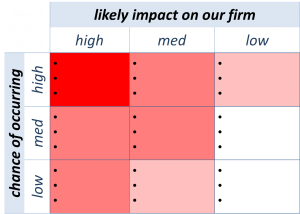 Environmental Scanning is (usually) a systematic attempt to address the two external factors in a SWOT Analysis—Opportunities and Threats. Understanding these two external factors—which are also two quadrants in the TOWS Matrix—is crucial in planning a firm’s success.
Environmental Scanning is (usually) a systematic attempt to address the two external factors in a SWOT Analysis—Opportunities and Threats. Understanding these two external factors—which are also two quadrants in the TOWS Matrix—is crucial in planning a firm’s success.
Although managers and planners have always attempted to understand their firm’s environment, Francis Aguilar can be credited with publishing the first systematic approach to environmental scanning in 1967.
Since then, other people have developed many variations on the environmental scanning theme. Some insist that an focusing on externals is really only half of an environmental scan; they argue that the internal environment of the firm is equally important. I will focus here only on the external environment, not because the internal environment isn’t every bit as important, but because not every strategic tool needs to do everything.
Amongst practitioners that focus on external environmental scanning, the main debates focus on what elements of the environment should be focused on. The simple answer is “everything”. After all, you can never be sure where an opportunity might be found, or what emerging issue might turn out to be a threat.
Unfortunately, the simple answer is not a very practical answer. There isn’t enough time to examine everything.
To try to make environmental scanning practical, practitioners usually propose a list of areas to focus on, usually shortened into an aconym. PEST (for “Political”, “Economical”, “Social”, and “Technological”), SLEPT (adding “Legal”), and STEEPLED (adding “Ecological”, “Ethical” and “Demographic” are all variants. My preference is for PESTEL:
- Political
- Economic
- Socio-cultural
- Technological
- Ecological
- Legal
Which acronym you choose doesn’t much matter; they are all intended to be a summary of multiple possible factors in the environment. So, for example, is you choose to leave out “Legal”, rather than ignoring changes in the legal environment that might affect our firm, you’ll want to make sure those are collected together under the “Legal” banner.
A good starting checklist of the types of issues that most firms should be consider within each area is found on Wikipedia:
- Political
- taxation policy
- trade regulations
- governmental stability
- Economic
- inflation rate
- growth (or decline) in economy
- disposable customer income
- Socio-cultural
- demographics
- values & beliefs
- language
- education
- Technological
- research & development
- migration to online
- rate of technological change
- Ecological
- competitive advantage
- waste disposal
- energy consumption
- pollution monitoring
- Legal
- employment law
- health and safety
- product safety
- product labeling
- advertising regulations
Research
 Few (if any) strategic planners develop a thorough and usable list of environmental factors likely to affect the firm without research. Outside consultants rarely know a firm’s environment well enough; managers within a firm are usually focused on operations, products, and customers, rather than on the broader environment.
Few (if any) strategic planners develop a thorough and usable list of environmental factors likely to affect the firm without research. Outside consultants rarely know a firm’s environment well enough; managers within a firm are usually focused on operations, products, and customers, rather than on the broader environment.
Systematic research can be expensive and time-consuming. Non-systematic research (i.e.: surfing the web) is likely to provide a few leads, but is equally likely to overlook crucial issues.
A useful alternative to both can be to assign each member of the strategic planning team a leading trade journal from our industry. Give them the task of reviewing all the issues from the last two years, looking for potential future developments that fit the PESTEL categories. And then ask them to make a short presentation on the six developments they read about that they think are most likely to occur, and to affect our firm.
Focus
An environmental scan is more likely to be useful if those doing it work to answer three crucial questions:
- What could change? The focus is not on the present environment, but on potential future environments.
- How would a particular change affect our firm’s ability to thrive?
- How likely is that change?
We are not simply trying to guess the future; we are trying to prepare our firm for it.
Issues Priority Matrix
One way keeping the focus on these questions is to slot potential changes into an three-by-three Issues Priority Matrix:
The people involved in the strategic planning process are required to slot the potential environmental changes they think will matter to the firm into one of these nine boxes–and are arbitrarily limited to no more than three factors per box.
The strategic plan should focus on the top left box, ignore the bottom right, and put some attention into the other boxes between these two corners.

